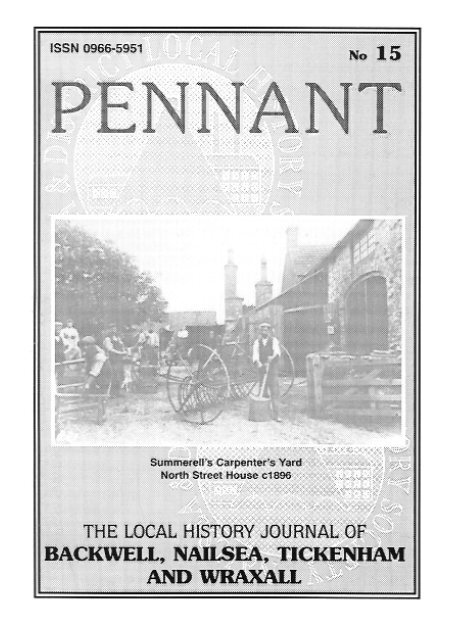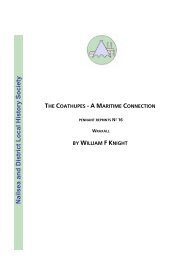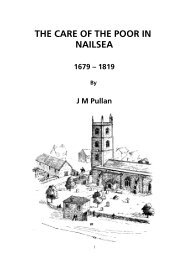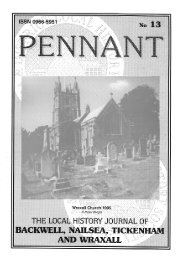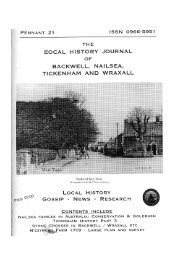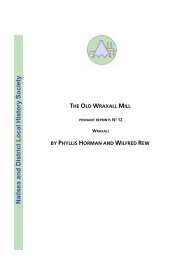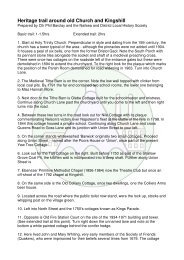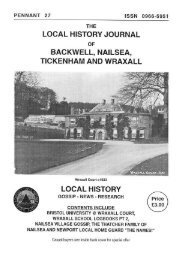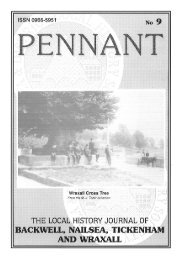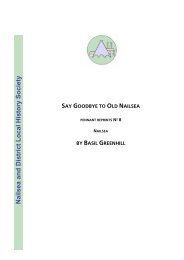No 15 - Nailsea and District Local History Society
No 15 - Nailsea and District Local History Society
No 15 - Nailsea and District Local History Society
Create successful ePaper yourself
Turn your PDF publications into a flip-book with our unique Google optimized e-Paper software.
Previously published by <strong>Nailsea</strong> & <strong>District</strong> <strong>Local</strong> <strong>History</strong> <strong>Society</strong>.This ebook version, © The respective authors <strong>and</strong> <strong>Nailsea</strong> &<strong>District</strong> <strong>Local</strong> <strong>History</strong> <strong>Society</strong>, PO Box 1089, <strong>Nailsea</strong> BS48 2YP,has been made available in August 2008, so that an individualmay download <strong>and</strong> read this document, for private researchpurposes only. It must not be reproduced or passed to a thirdparty without written permission of the copyright holders.
An Anniversary or two21 YearsCelebrating 21 years of work to ensure <strong>Nailsea</strong>’s heritage is notlost without being recorded the <strong>Nailsea</strong> <strong>and</strong> <strong>District</strong> <strong>Local</strong> <strong>History</strong><strong>Society</strong> will be holding an exhibition in Christ Church Vestry Hallin <strong>Nailsea</strong> on 5 th October. We hope to see you there.Among our major achievements in those 21 years have been theformation of a Civic <strong>Society</strong>, the preservation of a coal mine <strong>and</strong>saving John Whiting’s cottage. One aim remains unfulfilled. Thataim was to have a museum in <strong>Nailsea</strong>. We live in hope that thelatest proposed development will achieve our aim. In the past wehave been disappointed <strong>and</strong> wonder whether we will be yetagain.75 YearsOn Sunday 7 th July I attended the Dedication of the PoppyGarden of Remembrance in Stockway <strong>No</strong>rth, <strong>Nailsea</strong>. 1996 is thecelebration of 75 years of the Royal British Legion. I underst<strong>and</strong>that the <strong>Nailsea</strong> Branch was formed 6 days after the formation ofthe national body. About 75 people were there, most from theBritish Legion, together with clergy from six local churches. I tookit upon myself to represent <strong>No</strong> 2467 (<strong>Nailsea</strong>) Squadron ATC,<strong>Nailsea</strong> <strong>and</strong> <strong>District</strong> <strong>Local</strong> <strong>History</strong> <strong>Society</strong> <strong>and</strong> <strong>Nailsea</strong> Civic<strong>Society</strong>.<strong>Society</strong> NewsIn Pennant 14 I asked if anyone knew the regiments associatedwith some of those named on the Wraxall War Memorial. Theperson seeking that information was Anthony Price <strong>and</strong> notAnthony Stevens. Sorry for the error Anthony.George Knox has recently published a book prepared from acopy of the Times dated 22 nd June 18<strong>15</strong> which he found when
sorting out a late Aunt’s papers. Entitled Battle of Waterloo itmay interest members. Priced at £1-50 including p&p fromGeorge at his home address at 8 Woodl<strong>and</strong> Glade, Clevedon,BS21 6AL. Copies may be available from him for £1-00 at somemeetings of the N&DLHS.On 8 th July members went on a walk led by Brian Mayleddescribed in the programme as “A Countryside <strong>History</strong> ofBourton Wood”. The following report has been provided.On a bright dry evening, <strong>and</strong> firm under foot, twenty five of usclimbed the gently rising paths through this ancient woodl<strong>and</strong>.For two hours <strong>and</strong> a half, local naturalist Brian Mayled - who hasfrequented these woods for 37 years - kept us enthralled withinformation <strong>and</strong> anecdotes. Late into the evening as we wereexamining a badger trail leading to a dew pond Roger Mitchellspotted two Roe deer just a hundred yards away. “Worth almosta year’s subscription” commented one of our members. I’minclined to agree.Trevor Bowen<strong>Society</strong> ProjectsThe mention of farmhouses in the previous article reminds me towonder “How is our farm Survey going?” Would anyone like togive the editor a written report?Parish SurveyThat for <strong>Nailsea</strong> <strong>and</strong> Backwell was carried out by Jim Pullanc1976. It may be time to update this <strong>and</strong>, maybe, add moreentries. If you are interested in participating please contact theeditor or Trevor Bowen
<strong>Nailsea</strong> Memoriesby Peter WrightHaving been a resident of <strong>Nailsea</strong> for roughly the time that the<strong>Society</strong> has been operating I hope readers will find the followingnotes <strong>and</strong> illustrations bring back a few memories. These arefrom an unpublished manuscript which I hope to publish shortly.The shopping precinct now known as Crown Glass Shopping hasaltered mainly around the eastern extremity where Somerfieldsnow st<strong>and</strong>s. In 1976 this was an open space used for car parking<strong>and</strong> lorry parking. At the eastern end of Somerset Square stoodthe water feature. I never saw it at its best as it was intended tobe enhanced by running water. When I came to <strong>Nailsea</strong> thewater was off possibly in view of the drought we wereexperiencing but also I believe due to a defect.It closely resembled a girder type construction where the builderhad over-extended his credit before completing the project; itwas hard to realise that anyone would have wanted such an itemin a public place! Subject to much scorn it was eventuallyremoved in March 1978 <strong>and</strong> replaced by a platform subsequentlyused for various events. This platform has recently been removedin the latest refurbishment.In the area described above as a car <strong>and</strong> lorry park <strong>and</strong>immediately opposite the Queens Head stood a strange shapedbuilding that at one time was an enquiry office for the council. In1975/6 it was used by the Red Cross.By February 1988 the High Street had been altered <strong>and</strong> KingsCourt had been built <strong>and</strong> was occupied on the south side byWorlewind Videos <strong>and</strong> <strong>Nailsea</strong> Curtain Centre. This reminds methat a few years before there was another video shop Bernco?where the garden centre is now (opposite McGregors).
Fronting onto the High Street were Revelation <strong>and</strong> Shoes. Iassume that the signpost which then carried the sign“Clevedon” was damaged when Kings Court was constructed asI remember when there were two pointers. <strong>No</strong>w, of course afterrefurbishment, there are three. In 1988 Golden Valley Schoolcelebrated the Australian Bicentenary with a float in the <strong>Nailsea</strong>Carnival Procession.The bookshop, which had occupied the building used in the pastby Dr White for his surgery, moved when part of the High Streetwas rebuilt. It can now be found in premises just past the site ofthe old slaughter house. The wooden building, above theslaughter house yard, was for some time was used by the localremoval firm Loader <strong>and</strong> Munckton. That firm moved first toBlackfriars road <strong>and</strong> then to Avonmouth when they took overMartins Removals.Reflections on old belfry Rules at St. Andrew’s Backwell by JohnBrainOf all the groups of people from parish life associated with thechurch in historical terms, apart from the incumbents <strong>and</strong>churchwardens, one of the most consistent <strong>and</strong> mostdocumented in records are the bellringers. In the past theyenjoyed a rather dubious reputation, <strong>and</strong> until the OxfordMovements gained support <strong>and</strong> belfry reform complemented themany church restorations in the 19 th Century their oftendescribed “one foot in the church - one in the pub” was not allthat far off the mark. They were a strong <strong>and</strong> independent groupof men, with not a lot of regard for the parson, <strong>and</strong> their controlby the church authorities required a fairly comprehensive set ofrules, couched in terms which both sides recognised as firm butfair, <strong>and</strong> exhibited prominently in the belfry.
The old rules, written in beautiful copperplate, dated January1906, have been hanging in the belfry at St. Andrew’s Backwellsince those days, bearing the signature of the rector of the time,the Revd. E.S.S. Caudwell, but a few years ago the ringersdecided to renew the frame, <strong>and</strong> to our surprise <strong>and</strong> good luck,discovered behind them the previous set, dated October 31 st1901, agreed <strong>and</strong> signed by the previous rector <strong>and</strong> localeminent historian Prebendary Edward Burbidge. Both sets ofrules give a good insight on how jealously the ringers guardedtheir privileges, bearing in mind that paid ringing for specialoccasions constituted a more than useful addition to theirincome, in the days when an agricultural labourer would haveearned no more than fifteen shillings a week.There are, however, some interesting changes in our 1906 rules;in 1901 Burbidge was approaching the end of his 28 yearsministry in the parish, <strong>and</strong> although a man with an orderedapproach to things one suspects that he merely formalised theprevious rules, probably to tie in with the fact that the churchhad just undertaken the rehanging of its six bells which had beenrededicated in February of that year. By 1906 Mr Caudwell waswell installed as the new rector, <strong>and</strong> subtle changes to the rulesat least ensured the ringers gave a little more time <strong>and</strong> effort tothe service of the church than they had been used to in the past.Up to 1901 the rules stated “the usual ringing days are AdventSunday, Christmas Day, Easter Day, Whitsunday <strong>and</strong> New Year’sEve. The bells may be rung for service also on the last Sunday ofthe month”. It was almost as if ringing for ordinary services wasonly grudgingly accepted, along with a lukewarm rule 7: “It ishoped that when the bells are rung for service the ringers willattend such service unless prevented by some special reason” towhich was added (forcibly) “Any member who shall smoke orbring liquor or dogs into the belfry shall be expelled!”Caudwell’s rules were much more precise; “Ringers shall bechurch goers, <strong>and</strong> shall on no account walk away from a service
after ringing unless for a special reason to be stated to thePresident”.The belfry door at Backwell may allow the easy opportunity toslip out unnoticed, but the Rector could hear the six bells (as theywere then) being rung <strong>and</strong> his eagle eye would have ranged overthe congregation, <strong>and</strong> checked the number of ringers present!Caudwell added Ascension Day <strong>and</strong> Harvest Festival to theringing festival days, <strong>and</strong> in future the bells were to be rung “forordinary services of the church” instead of just the 4 th Sunday.What is striking is the rigidity of these old rules, both in theconduct of the ringing <strong>and</strong> in the inflexibility in membership.Apart from designating the Rector as President, <strong>and</strong> the twochurchwardens as vice presidents of the Guild, membership in1901 consisted of “not more than eight ringers <strong>and</strong> twoprobationers”, which was increased to 12 in 1906 to include aLeader, a sub leader, a treasurer <strong>and</strong> a steeplekeeper, theleader’s job being “to call the ringers together (no telephonesthen) for teaching, <strong>and</strong> for seeing that the rules were observed”.The steeplekeeper will (sic) “oil the bells, tighten the nuts, <strong>and</strong>keep the belfry clean”.Business meetings were to be held quarterly on the first Tuesday,which was normally practice night, except in Lent, or if aparishioner was lying dead in the parish, <strong>and</strong> in contrast totoday, when ringers from other parishes are made welcome ineach other’s towers, in 1906 “no one but a member of the Guildshall be allowed to enter the belfry without special permissionfrom the President” There was even a pecking order when itcame to manning the bells - “the ringers will be enrolled in afixed order, <strong>and</strong> in the event of a ringer being unable or notwishing to ring, the next in order on the list shall be entitled tofill his place”.
Reference has been made to paid ringing, a feature of the 19 thCentury <strong>and</strong> before that; the 1901 rules required a payment of5/-d from would be ringers - 2/6d to the Leader on entry, <strong>and</strong> afurther 2/6d to the general fund “when able to ring in peal”.Fees payable probably made it all worth while, the customarycharges being set as follows: for the day £2/2/0d; for part of aday £1/10/0d; for a muffled peal £1/1/0d - all monies to bedivided amongst those (six ringers) who ring”.Remember that in most towers there was also paid ringing on<strong>No</strong>vember 5 th <strong>and</strong> May 29 th to mark, respectively, the failure ofGuy Fawkes to blow up Parliament <strong>and</strong> the restoration of theMonarchy under Charles II. Other payments in Backwell’saccounts include £1/0/0d to the ringers on Queen Victoria’smarriage in 1840, <strong>and</strong> £1/1/0d for a muffled peal for theMarquis of Bath (the church’s patron) in 1897. A further sourceof income came from touring the parish with the h<strong>and</strong>bells atChristmastime to collect donations from all <strong>and</strong> sundry, especiallythe big houses, who would provide supper into the bargain. Allpayments went into a common fund, <strong>and</strong> were shared outequally at Christmas.Changes to these old fashioned practices were a long timecoming, but Jim Lott, an old Backwell ringer, who still chimes thebells once a month at the great age of 94 has clear memories ofthe old ringers of that far off era who were required to signacceptance of the rules “in a book to be kept by the Presidentfor the purpose”.Perhaps our rules are a little more relaxed in 1996, but I like tothink, as we continue our art Sunday by Sunday, that we stillremember the heading which prefaced the Rules of both 1901<strong>and</strong> 1906 : “Do all to the Glory of God” - perhaps the best ruleof all?
Little Manor, West Endby Peter WrightThe June meeting of the <strong>Society</strong> was held at Little Manor at theinvitation of Mr & Mrs Hale the owners. The weather wasbeautiful <strong>and</strong> all those who went had a thoroughly enjoyabletime looking round the old house <strong>and</strong> receiving refreshments.Thanks were expressed to Mr <strong>and</strong> Mrs Hale by Trevor Bowen <strong>and</strong>I have pleasure in repeating them here. A fascinating house toexplore with so many mysteries!I have read the report of an examination of the property in 1990<strong>and</strong> made the following summary. I thank Mr <strong>and</strong> Mrs Hale forallowing me to read it <strong>and</strong> prepare the following notes. Thereport is signed by E.H.D. Williams <strong>and</strong> notes that Miss P.Brimacombe assisted with this record.“Little Manor is a house of exceptional length 69ft <strong>and</strong> is of twofull storeys for 23ft at the E end but only one <strong>and</strong> a half storeyswith upper windows in tall gabled dormers for the W 46ft; to theN abreast the latter but partly overlapping the former is a one<strong>and</strong> a half storey wing with similar gabled dormers. The roof istiled with coped gable at the W end <strong>and</strong> on one wing, but thetall part has plain verges; the depth of coping indicates anoriginally thatched roof”.The angular alignment of the wing is unexplained. It is suggestedthat it was built as a kitchen in the 17C whilst the outer roombecame a low-ended parlour, a rarity in Somerset occurring inoriginal long-houses, combined house <strong>and</strong> byre.In the angle with the wing is a spiral stair. The report suggeststhat it is possible that the tall part of the house is a late (probably19C) rebuild <strong>and</strong> extension of the inner room of the originalhouse.
There is said to have been a datestone of 1661 no longer visible.I infer from the report that the original building of three room<strong>and</strong> cross passage plan could be earlier. There are spiral stairsabreast the hall stack , which the report says are typical of suchan earlier house.The walls are described as being between 20 inches <strong>and</strong> 2 feetthick with the tall E end somewhat thinner.The windows are a mixture of copies <strong>and</strong> originals. “The knowncopies are so exact that it is difficult to be sure how many of theothers are (or are not) original”. The windows are all underangled dripmoulds. These are unusual as they are not “ofdressed stone but are composed of irregular lengths of the localslab shaped rubble”.In the late Jim Pullan’s (JMP) Parish survey of <strong>Nailsea</strong> which hecarried out c1976 he mentions the following two references tobuildings called West End Farm at various times:JMP records“West End Dairy Farm” - shown as West End Farm on the OSmaps. The house known as Little Manor was originally a WestEnd Farmhouse. The adjoining buildings now used for dairy workare recent. Source Mr Biggs. JMP also had information from MrWhitefield who moved from Little Manor to <strong>Nailsea</strong> Court. JMPsuggests that the building was 17C. National Grid Reference(NGR) 4440 6900.JMP then describes“West End Farm” NGR 4455 6920Described as West End Farm on the sale plan of 1874. The houseappears to be 17C but buildings behind appear to be older. Awell in front has recently been filled in. Large round stone <strong>and</strong> apossible stone quern. Information given to JMP by Mr Stevenson.
(Ed. Pocket Oxford Dictionary “Quern” H<strong>and</strong> mill for grindingcorn)Quoted with permission of Secretary of BAAS. In quoting thisinformation I acknowledge the encouragement given by BAAS(previously the Bristol Archaeological Research Group) <strong>and</strong>Somerset Archaelogical <strong>and</strong> Natural <strong>History</strong> <strong>Society</strong> to thepreparation of Parish Surveys <strong>and</strong> the efforts of our late Presidentin carrying out work in the local parishes for the former.Disappearing Wraxallby Phyllis HormanHaving moved from Wraxall to <strong>Nailsea</strong> in 1948 I have not seenmany alterations to the village, no doubt a lot has changed that Iknow nothing about. However there are a few which have beenmost notable to me.Firstly, the Cross Tree at the junction of the B3130 road <strong>and</strong>Wraxall Hill. This tree was a large elm reputedly the third to havebeen planted on that spot after the market cross was removed inCromwell’s time. It was, in my childhood days, the centre of thevillage, the pickup point for getting on the “charabanc” (coach)for the Sunday School annual trip to Weston super Mare, it wasthe bus stop <strong>and</strong> the general meeting place for everyone.Unfortunately it was killed by Dutch Elm disease in the late1960’s or early 1970’s. Three new trees were planted but eachdied off, but now there is a young oak which seems to besurviving, but the Cross Tree doesn’t seem to be the same to menow.The Battle Axes Hotel was built on the site of a former inn. In1881 Mrs Matilda Blanche Gibbs had the Battle Axes built as aTemperance house <strong>and</strong> estate club for the Tyntesfield workmen.
The design on the original inn sign was taken from the coat ofarms of the Gibbs family. The Battle Axes has changed h<strong>and</strong>sseveral times since Lord Wraxall sold it in 1962, one ownerdecided to rename it the Widecombe Arms, which was a stupididea as Widecombe isn’t even in Somerset, however several yearsago the name was changed again, this time to the New BattleAxes. There have been extensions added but somehow it doesn’tseem to have spoilt the original design. The part which has beendestroyed was the stable building, later used as a school cookeryroom, a firing range for the local rifle club <strong>and</strong> also a piggery, allat different periods of time, of course! When it was finallydemolished it became the car park for the hotel.Going toward Bristol <strong>and</strong> passing the Jubilee Cottages - thealmshouses built by the Gibbs family in the later 1800’s for theirretired work people - across the field on the right h<strong>and</strong> side, isthe ruin of Watercress Farm. This must have been a very oldbuilding, the son of the farmer who had lived there told me thatit was built back to front as all the rooms faced north <strong>and</strong> thesouth side was one long passage way. It was an attractivebuilding but about 1967/8 there was a fire caused by anelectrical fault. Fortunately no one was injured but since then thefarm has been left to rot away.Immediately after passing Jubilee Cottages, on the left, there wasa very nice square built house, with the outside walls paintedwhite. This was the Tyntesfield butler’s house <strong>and</strong> when I was achild the butler was Mr Hemmings. This year there was a firewhich destroyed part of the roof, all the windows are out, thewhite walls streaked with smoke. The family who were livingthere escaped, but all their possessions were destroyed. Will thishouse ever be restored?Two lodge cottages known as Ivy Lodge stood on either side ofone of the Tyntesfield Drives, they were connected by anarchway. These were demolished some years ago, but I still look
for them when I go along that drive. There are two more lodgecottages belonging to the estate which are in a ruinous state,one is at the top of Belmont Hill, the other a little nearer SixtyAcres. These were both very attractive Victorian Buildings.The mill which was at the bottom of the Score was demolishedfor road widening probably in the 1960’s. A pretty little cottagewas used as a private dwelling after 1900 when the mill ceasedto be used. Later when Mrs Griffin <strong>and</strong> her son were there thesmall front hallway was used as a sweets <strong>and</strong> tobacco shop,while the mill building was used by the son for boot <strong>and</strong> shoerepairs. During the second world war it was occupied by some ofthe evacuee families.The biggest loss I think was a small chapel built on West Hill,now called Stony Steep. It was close to three cottages <strong>and</strong> in oneof them lived my gr<strong>and</strong>parents <strong>and</strong> later <strong>and</strong> aunt <strong>and</strong> uncle. Itmay still have been in use occasionally in the early 1930’s as oneof my sisters clearly remembers that on returning home, aftervisiting Gr<strong>and</strong>ma on a Sunday afternoon, Mother would tell us tobe quiet as we passed the chapel <strong>and</strong> that there were people inthere singing hymns. This I cannot remember but I can clearlyvisualise the chapel in my mind. My brother had been inside as achild, although he thought the chapel was not then used assuch, <strong>and</strong> he remembers that around the walls was the text“When two or three are gathered together in Thy name”. AtTaunton Record Office I found an application for a Bishop’slicence to hold <strong>No</strong>n-Conformist worship in a person’s house,which may have led to this chapel being built at a later date. Thehouse was in the occupation of Sophia Roberts, the date of theapplication was <strong>15</strong> th January <strong>and</strong> was granted on the 22 nd January1821.I found that a family of Roberts were living either on West Hill orthe base of the Hill about that time. Quite a number of years agoa large piece of l<strong>and</strong> was sold for market gardening. This l<strong>and</strong>
included the chapel <strong>and</strong> through this sale the chapel wasdemolished. Had I been aware of what was about to happen, Iwould have taken photos but no one seemed to talk about it ortake an interest in the chapel; it was not a pleasant surprisewhen I walked that way to find the chapel no longer there.What a pity so much has disappeared or changed. Overall,Wraxall looks very much as it did when I was still living there,but, knowing the village well, I can easily pick out the emptyspaces <strong>and</strong> ruins.Oh dear; goodbye old Wraxall.“The Five-Pint Cider Mug”Extracted from “Picture Post dated October 21 1944.Price 4d”(Ed. 4d is equivalent to 1.7p compare that to prices of currentmagazines. The illustrations in the photocopy are not suitable forreproduction. The Editor acknowledges that the copyright of theoriginal article <strong>and</strong> magazine remains with the current owner ofthe Title)The cover of this edition of “Picture Post” shows Mr ReginaldWear of Honeyhall Congresbury drinking from the five-pint cidermug which carries the words “John Wear Congresbury 1874”(Reginald’s gr<strong>and</strong>father). The reason that I mention this is thatthe article in the magazine then goes on to discuss the making ofcider <strong>and</strong> contains among the illustrations a picture “ItalianPrisoners Press the Apples” followed by the explanation “ AtMessrs Coates of Somerset, Italian prisoners have been broughtin to help press this year’s record apple crop”.A half page picture shows 6 men <strong>and</strong> three large cider vatswhich bear the names “Churchill” “Roosevelt” “Stalin”. The
caption reads “Every vat at this big cider maker’s has its ownname. On average, every vat holds 10,000 gallons. Britain drinks20,000,000 gallons of cider a year. So you can work out howmany vats like this are needed to store the year’s cider supplies”.The last paragraph mentions that if you follow the farm cartsdragging the red <strong>and</strong> green, yellow <strong>and</strong> brown loads of applesback to the farm, the horse will lead to the cider - house. You’llrecognise it by the old casks lying about outside. But you’ll knowyou are coming to it long before that by the heavy perfume ofapple juice in the air. It’s the sweetest <strong>and</strong> most penetrating ofall the autumn smells.This reminder of times past brings us to the following articlewhich shows that 25 years later certain aspects of <strong>Nailsea</strong> werestill the same: -Where has the smell gone?by Bid WheelerI left <strong>Nailsea</strong> in 1969 having finished 7 years at <strong>Nailsea</strong> GrammarSchool, <strong>and</strong> only returned to live herein 1991, <strong>and</strong> one of themost noticeable changes was the smell of the place - it no longerhad one!As a girl in the 1960’s I lived in Tickenham <strong>and</strong> travelled to<strong>Nailsea</strong> Grammar School by bus, getting off at the stop in HighStreet just near the Queens Head, then walking down the pathopposite through the archway which still remains besideReflections, Hairdressers, to Station Road <strong>and</strong> into MizzymeadRoad which was built then to only just beyond the school mainentrance.On the homeward leg of the journey, I <strong>and</strong> one other pupil usedto walk to the stop near the Royal Oak to enable us to get a seat
on the bus before all the other pupils got on at the QueensHead. (In those days of course <strong>Nailsea</strong> Grammar attracted pupilsfrom a large surrounding area including Clevedon, Portishead,Long Ashton, Backwell <strong>and</strong> Yatton with most arriving on coachesbut some had season tickets for the ordinary bus).It was at the Royal Oak Bus stop that the smell of <strong>Nailsea</strong> cameinto its own - the stench of rotten apples from Coates CiderWorks. We would st<strong>and</strong> there gazing down the road towardsWraxall watching for the bus to make its way along the bendyroad, breathing in this all pervading stink of rotten apples.<strong>No</strong>w I’d been brought up visiting a gr<strong>and</strong>mother who lived inBurton-on-Trent, <strong>and</strong> was used to the smell of brewing as weapproached on the train - Mum would open the train window<strong>and</strong> you could soon tell you were approaching by the pong!<strong>Nailsea</strong> was very similar - you could tell by the smell that therewas a cider works somewhere in the area. You’d have thoughtthat the pong would have been blown away from the villagecentre, with the factory being on the east side of the village, butno, it made its presence smelt all the same.Having moved away for 20 years, I now miss the “aroma” - itdoes seem that something is missing. <strong>No</strong>wadays <strong>Nailsea</strong> smellsthe same as many other towns - with traffic fumes thepredominant one. It doesn’t have the same character as <strong>Nailsea</strong>of old!
A LOCAL BIBLIOGRAPHYPART 2 continuedSection BPublished by <strong>Nailsea</strong> <strong>and</strong> <strong>District</strong> <strong>Local</strong> <strong>History</strong> <strong>Society</strong>.Books A4 size -Typed <strong>and</strong> duplicated; bound with staple or slidebinder.O/P = out of print, photocopies may be available, contactN&DLHS for availability <strong>and</strong> prices.TITLE AUTHOR(s) PUBN ISBN/ PRICE REMARKSDATE ISSN<strong>Nailsea</strong> - The Storyof Our Village<strong>Nailsea</strong> WIs 1980 <strong>No</strong>ne O/P a reprint of thebook originallypublished in 1953by <strong>Nailsea</strong> WIsCare of the Poor in J. M. Pullan 1980 <strong>No</strong>ne £2-00<strong>Nailsea</strong>In <strong>Nailsea</strong> <strong>and</strong> Far Jack Hart 1981 <strong>No</strong>ne O/PAfieldMemories ofWraxall 1917 -1935Wilf Rew 1981 <strong>No</strong>ne O/P<strong>Nailsea</strong> Then <strong>and</strong><strong>No</strong>wBrockley withChelveyA Place Set Apart -The MethodistChurch in <strong>Nailsea</strong>Roads <strong>and</strong> Tracksof Old <strong>Nailsea</strong>Around <strong>and</strong> AboutMargaretThomas <strong>and</strong>David Cains1982 <strong>No</strong>ne O/PJ M Pullan 1983 <strong>No</strong>ne O/PTrevorBowen1983 <strong>No</strong>nePeter Wright 1984 <strong>No</strong>ne O/PEd. Thom<strong>and</strong> Wright1984 <strong>No</strong>ne £2-00 see entry in Part 2A inPennant <strong>No</strong> 14
Section CStyle A5 l<strong>and</strong>scape Published by <strong>Nailsea</strong> <strong>and</strong> <strong>District</strong> <strong>Local</strong> <strong>History</strong><strong>Society</strong>Typed <strong>and</strong> duplicated; stitched. Published in 1979 <strong>No</strong> ISBN/ISSN.<strong>No</strong>w out of print.John Robert LucasHannah Moreby B. J. Greenhillby B. J. GreenhillSection DStyle A5 book Published by <strong>Nailsea</strong> <strong>and</strong> <strong>District</strong> <strong>Local</strong> <strong>History</strong><strong>Society</strong>PRINTED; stitched. <strong>No</strong> illustrations. Published in 1977. <strong>No</strong>ISBN/ISSN. <strong>No</strong>w out of print.The <strong>Nailsea</strong> I Knew 1910-1918by Jack HartSection EPennant the <strong>Local</strong> <strong>History</strong> Journal of Backwell, <strong>Nailsea</strong>,Tickenham <strong>and</strong> Wraxall ISSN 0966-5951Published by <strong>Nailsea</strong> <strong>and</strong> <strong>District</strong> <strong>Local</strong> <strong>History</strong> <strong>Society</strong> <strong>and</strong> printedby Adroit Printers.Back <strong>No</strong>s. 1 to 12 still available sold only in sets.Single copies of some editions are also available as at 1 July 1996
Section FPublished by <strong>Nailsea</strong> <strong>and</strong> <strong>District</strong> <strong>Local</strong> <strong>History</strong> <strong>Society</strong> <strong>and</strong> printedby Adroit PrintersPRINTED <strong>and</strong> stitched. Size A5 unless otherwise indicated.TITLE AUTHOR(s) PUBNDATE<strong>Nailsea</strong> Village Gossip<strong>Nailsea</strong> Village NewsMills on the L<strong>and</strong> YeoMills on the L<strong>and</strong> Yeo -Further Discoveries<strong>Nailsea</strong> ParochialSchool - AdmissionsRegister 1877 - 1911Holy TrinityChurchyard, <strong>Nailsea</strong>:Tombstone Inscriptions1978<strong>Nailsea</strong> Village Institute<strong>and</strong> Church HouseA Short <strong>History</strong> ofChelveyYoungwood Lane,<strong>Nailsea</strong> -An HistoricalL<strong>and</strong>scape - well worthexploringPhyllisHormanPhyllisHormanMartinBodmanRuth Poole &othersPrepared byGeorge KnoxEdited byPeter WrightChristine MMilton<strong>No</strong>rmaKnightMargaretThomasISBNISSNPRICEREMARKS<strong>and</strong> relevantseries10/92 0 9516258 1 0 O/P Newspaperaccounts oflife inVictorianTimes08/93 0 9516258 2 9 £0-50SpecialSale04/94 0 9516258 3 7ISSN 1353-396712/94 0 9516258 4 5ISSN 1353-396712/94 0 9516258 5 3ISSN 1354-5612FurtherNewspaperAccounts oflife inVictoriantimes£1-50 PennantSpecial <strong>No</strong>1£1-50 PennantSpecial <strong>No</strong>2£5-00 <strong>Nailsea</strong>Records <strong>No</strong>2size A4LANDSCAPE03/95 0 9516258 6 1 £2-00 <strong>Nailsea</strong>Records <strong>No</strong>108/95 0 9516258 7 XISSN 1359-009X03/96 0 9516258 8 8ISSN 1353-396706/96 1 900772 00 0ISSN 1359-009X£2-00 People <strong>and</strong>Places <strong>No</strong> 1£2-00 PennantSpecial <strong>No</strong>3£0-60 People <strong>and</strong>Places <strong>No</strong> 2NB somecopies carryISSN 1359-0096 inerror
Published by <strong>Nailsea</strong> <strong>and</strong> <strong>District</strong> <strong>Local</strong> <strong>History</strong> <strong>Society</strong> inassociation with the authorTITLE AUTHOR(s) PUBN ISBN/ISSN PRIC REMARKSDATEEVillages at War;Backwell, <strong>Nailsea</strong>,Tickenham <strong>and</strong> Wraxall1939 - 1945Peter Wright 05/90 0 9516258 0 2 £2-99 (jointly withPeter Wright)A LOCAL BIBLIOGRAPHY is to be continued in Pennant 16
Family <strong>History</strong>by Peter WrightA Fruitful Mention in Family Tree MagazineReaders will know that the <strong>Society</strong> has been in correspondencewith several descendants from local families over the years. Itwas a pleasant surprise to find a reference to one of ourpublications in Family Tree Magazine (June 1996).This was in the section of comments in diary form by AnthonyCamp Director of the <strong>Society</strong> of Genealogists where hementioned that <strong>Local</strong> <strong>History</strong> Magazine had reviewed theunusual “<strong>Nailsea</strong> Parochial School Register 1877 - 1911 edited byPeter Wright (on behalf of <strong>Nailsea</strong> <strong>and</strong> <strong>District</strong> <strong>Local</strong> <strong>History</strong><strong>Society</strong>)” <strong>and</strong> quoted my address.Within a week I had an order for one copy from a professionalresearcher in Sussex <strong>and</strong> 5 copies from a firm that undertakessimilar research. I have also had queries about the SHEPSTONE,JONES <strong>and</strong> LOCK families.Mr A. J. Thompson of 18 Riverside Close Upton on SevernWorcs. WR8 0JN is making a study of the name SHEPSTONE <strong>and</strong>enquired what the register showed for that family. He has sentme much information <strong>and</strong> I have sent the details set out below.This does not represent all we know about the family as there ismuch in Phyllis Horman’s <strong>Nailsea</strong> Village Gossip.(The editor would welcome any further information about anylocal families, if you have any please drop him a line).
Shepstone -ENTRIES IN THE NAILSEA PAROCHIAL ATTENDANCE REGISTER1877 - 1911Col 7 showing progress was seldom completed <strong>and</strong>, to savespace, has been omitted.1CHRISTIANNAME2Adm<strong>No</strong>3Date ofAdmission4Residing at5Born6Previousschool8Date ofWithdrawalReason9ParentorGuardianCornelius10Occpn.ARTHUR 1263 08/04/07 West End 11/09/03 <strong>No</strong>ne 14/09/17AgeDealerCHARLES 881 08/03/97 Kings hill 24/04/93 <strong>No</strong>ne <strong>15</strong>/02/07* Cornelius LabCORNELIUS 1178 04/05/04 West End 12/07/00 <strong>No</strong>ne 14/07/04 Cornelius DealerAgeELIZ JANE 755** 28/01/01 West End 12/02/90 N. Paroch 02/02/04 Cornelius DealerELIZ JANE 755* 19/10/96 Kings hill 12/02/90 Pentcray, 25/04/00 Cornelius LabWalesELIZA JANE 755 10/04/93 Kings hill 12/02/90 21/05/94 Cornelius LabGEORGE 925 18/04/98 Union St 26/03/95 <strong>No</strong>ne 22/05/08 Cornelius DealerExempt byexamSIDNEYERNESTWALTEREDGARWILLIAMJOHN1331 19/04/09 OldChurch19/08/05 <strong>No</strong>ne 25/07/19AgeCornelius Dealer1114 16/02/03 West End 8?/03/99 <strong>No</strong>ne 03/02/13 Cornelius DealerAge981 13/06/99 Union St 04/12/96 <strong>No</strong>ne 23/12/09* Cornelius Dealer96 over 95<strong>No</strong>tes:881 Charles * Apparently given Certificate of ?Prev. Attendance981 William John similar note to the aboveWalter Jones - SchoolmasterAnother enquiry that I received was in connection with aschoolmaster called Walter Jones. Would he have been at theParochial School? I was able to say no <strong>and</strong> point out that he wasat what is now Four Oaks.The enquirer was a Mrs Linda Wake of 7 Shadwells Road,Lancing West Sussex, BN<strong>15</strong> 9EN who was descended from hisbrother. In reply I have sent her a copy of Christine Milton’s bookabout the school <strong>and</strong> much about Walter Jones. To this I addedthe details we have readily available. For these I have to thank
Phyllis Horman <strong>and</strong> Millie Knox. As Walter is one of the peoplewho had a great influence on the youth of <strong>Nailsea</strong> over manyyears I repeat the information here for a wider audienceNOTE BY PHYLLIS HORMANThe only item of interest that Eileen’s mum ( Mrs Derry) told her about MrJones was that he boxed Mabel Binning’s ears <strong>and</strong> made her deaf for therest of her life!CHRIST CHURCH – NAILSEA SOMERSET BAPTISMS ENTRIES UP TO 1939NAME PARENTS DIST. FATHER’S DATEOCCUPATIONWALTER s.o Walter & Sarah Maria Thomason Ch.Ch. Nat. Schoolmaster 6 th Feb 1876WILLIAM . JonesFLORENCE d.o Walter & Sarah Maria Thomason Ch.Ch. Nat. Schoolmaster 27 Jan 1878DAISYELIZABETH. JonesHERBERT s.o Walter & Sarah Maria Thomason Ch.Ch. Nat. Schoolmaster 3 Jun 1883. JonesLILIAN d.o Walter & Sarah Maria Thomason Ch.Ch. Nat. Schoolmaster 3 Jun 1883MAUD . JonesSAMUEL s.o Walter & Sarah Maria Thomason Ch.Ch. Nat. Schoolmaster 1 Mar 1885GEORGE . JonesFREDERICK s.o Walter & Sarah Maria Thomason Ch.Ch. Nat. Schoolmaster 9 Mar 1889COURTNEY . JonesPERCIVAL s.o Walter & Sarah Maria Thomason The School Schoolmaster 27 Oct 1895. JonesRENEE AMY d.o Samuel George & Amy Rebecca Ch.Ch. Clerk 1 Sep 1912. Collett JonesMARGORIE d.o Samuel George & Amy Rebecca Silver St Clerk 23 May 19<strong>15</strong>MAY. Collett Jones<strong>Nailsea</strong>GORDON s.o Samuel George & Amy Rebecca Hillview Clerk 1 Feb 1920SAMUELCollett JonesSilver StREX GEORGE s.o.Samuel George & Amy RebeccaCollett JonesHillviewSilver StClerk 16 Dec 1923DOUGLASSRAWLINSONs.o.Percival & Charlotte ElizabethJonesRestl<strong>and</strong>s<strong>Nailsea</strong>CHRIST CHURCH NAILSEA MARRIAGESGROOM & BRIDE STATE AGE OCCUPN. LIVING AT NAME OFERNEST WILLIAMWYATTFLORENCE DAISYELIZABETH JONESBac 28yearsSpin 22yearsFarmerMizzeymead<strong>Nailsea</strong>Ch. Ch.Clerk 14 Dec 1919DATE OFFATHER MARRIAGEJames 16 Oct 1900Walter
GROOM & BRIDE STATE AGE OCCUPN. LIVING AT NAME OFFATHERDATE OFMARRIAGEHENRY FRANCIS Bac 24 P.O. Clerk Horfield Henry F. 17 Apr 1906TAYLORyearsLILIAN MAUDJONESSpin. 26yearsCh. Ch. WalterGROOM & BRIDE STATE AGE OCCUPN. LIVING AT NAME OFFATHERDATE OFMARRIAGESAMUEL GEORGE Bac 26 Clerk Ch. Ch. Walter 12 Sep 1911JONESyearsAMY REBECCACOLLETT BAKERSpin 23yearsCh. Ch. Theodore J.CHRIST CHURCH NAILSEABURIALSNAME AGE PLACE DATESARAH MARIA THOMAZINE JONES 71 years Brook farm, Backwell 22 <strong>No</strong>v 1922WALTER JONES 86 years Tyntesfield Wraxall 28 Jan 1937WALTER WILLIAM JONES 77 years 51 Millington Rd Leamington 31 Oct 1952When the 1891 census was carried out Walter was theenumerator. The following information was entered <strong>and</strong> kindlysupplied by Millie Knox. I did not ask for details of any children:-1891 living at Christ Church School <strong>No</strong> 13 Silver Street <strong>Nailsea</strong>Walter Jones, Head, Married aged 40 certified ElementarySchoolmaster, , born Gloucestershire Bristol.Sarah M. T. Jones married, aged 39, no occupation, bornGloucestershire, Bristol.Also at same address Louisa Jones sister, unmarried, tailoress,age 48, born Gloucestershire, Bristol.Linda Wake sent me a list of relatives of Walter <strong>and</strong> she told meon the telephone that she had previously thought that Louisawas a younger sister. Details are as follows:-John Jones married Elizabeth Collings on 26 June 1837issueAlfred mar. 1 Sarah Sophia Day 2 ?;Walter married ? headmaster <strong>Nailsea</strong> School;John Married Alice;
William Henry (Tailor <strong>and</strong> Organist) mar. Margaret Jane Day(sister to Sarah above) ?19 May 1871;Elizabeth;Sarah married Eli Lewis (something to do with <strong>Nailsea</strong>);George (Violin maker);Frederick;Louisa (Tailoress);Emma married ? Gibbs.(NB list of names not necessarily in order of age)LockI have also had a telephone call from Edmonton in N. Londonenquiring about the LOCK family. The enquirer is Gary T Boudierof 74 Grosvenor Road, Lower Edmonton London N9 8RJ who isconnected via a branch of the LOCK family that went to Walesfrom <strong>Nailsea</strong>. I now have seven pages of descendants fromStephen Lock b 1742 d 1817 <strong>and</strong> Betty Berran b 1745 d 1828married in Backwell Parish Church 12 July 1767.If you have any information about any of these families please letthe editor know.


